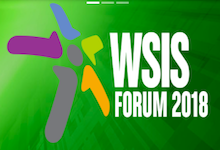Creating impact with open data within agriculture
19 Mar 2018 16:30h - 18:15h
Event report
[Read more session reports from the WSIS Forum 2018]
Mr Willen Schustra, of the Dutch Ministry of Agriculture, Nature and Food Quality, mentioned the Zero Hunger Challenge as one of the priority area for the Netherlands, in relation to the sustainable development goals (SDGs). He said that open data can greatly contribute to achieve this goal. The Netherlands established a triangle between government, business, and knowledge in order to implement solid data-driven public-private partnerships for agriculture. Open data can be used in many ways, for example: to optimise precision technologies for crops, better harvesting, and regulation of pesticide use.
Further, Schustra introduced several projects that are performing services in Africa and the Middle East. The first was the GODAN Network which encompasses open data for agriculture and nutrition. Its main objective is to bridge the gap between data and small farmers, which is facilitated by business support. The second was the Geodata for Agriculture and Water (G4AW) initiative, supervised by the Netherlands Space Office and the Ministry of Foreign Affairs. The main feature of the G4AW is that data is user demand-driven and helps to stimulate private investments. Currently G4AW runs 17 projects in 10 countries covering from 5 to 10 million small farmers.
Mr Sander Janssen, of Earth Informatics, continued the discussion on how open data can impact agriculture, and provide more details on the GODAN project. First of all, data helps to visualise different situations and problems faced by farmers, thus attracting more attention from mass media and eventually from the local authorities. The main activities of GODAN are: improvement of the interoperability of different forms of data; improvement of tools for impact assessment; and development of courses about open data usage. In assessing the impact of open data, GODAN uses several metrics like the level of political will to support open and transparent data, access to ICT for data providers and users, the general business climate in a region, and the technical skills of farmers. In conclusion, Janssen mentioned the obstacles to gathering reliable and comprehensive data for nutrition in targeted regions. To this end, open data for nutrition can improve the targeting of the programmes to reach the most vulnerable populations, and track accountability of their implementation.
Mr Koen Verbern, of the Waterwatch Cooperative, provided the commercial point of view on the issue, and briefly described the main activities of his company. It has three main components. The first is the geospatial data (based on geo data) such as certification of tea, coffee and cocoa crops to increase the transparency of supply chains and reduce costs. The geospatial data support audits, help to monitor control points on a monthly basis, as well as to observe remote fields. The data include biomass production rate, quality indices of crops and soils, deforestation, and crop water usage. The second component is provision of advice to farmers on what to grow, and where and how, using the same data. The last is financial services for farmers to assist in risk assessment and insurance for small farms. Verbern highlighted that the distinctive feature of the company is to provide sustainable services for a small fee, even after the project ends, and stimulating local banks to provide inexpensive loans for farmers to keep them using the data and running their businesses.
By Ilona Stadnick
Related topics
Related event

